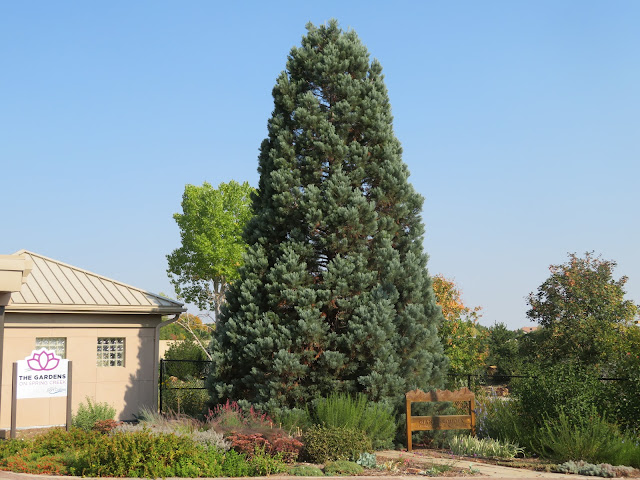In this June
2019 photo taken by Tim Buchanan, the ‘Hazel Smith’ has no sun scalding.
What's Blooming: Giant Sequoia
By Linda Harty, Senior Communications Specialist
The Journey of the Sequoiadendron giganteum ‘Hazel Smith’ at The Gardens on Spring Creek
In the heart of Fort Collins stands an iconic giant sequoia. The Sequoiadendron giganteum 'Hazel Smith' has graced the entry of The Gardens on Spring Creek for years, captivating visitors with its towering presence. Our guests often ask how this tree wound up at The Gardens.
The story begins with a visionary named Jim Clark, the founder of The Gardens on Spring Creek. Clark’s passion for horticulture and his dream of creating a community horticulture center brought him to Fort Collins in the early 1990s. Tim Buchanan, Fort Collins city forester from 1977 to 2018, crossed paths with Jim and was immediately inspired by his vision and determination. Buchanan’s connection with Clark marked the beginning of Buchanan’s involvement with The Gardens on Spring Creek.
Clark tirelessly pursued his dream of establishing a community horticulture center in Fort Collins. He connected with Buchanan and received support from the City of Fort Collins to bring his vision to life. Years of fundraising, presentations to the City Council, and land acquisitions culminated in the birth of The Gardens on Spring Creek.
The giant
sequoia—a majestic addition
Among the many trees that found a home in The Gardens on Spring Creek, this individual of a cultivar called ‘Hazel Smith’ stands out—not only because of its beauty and its prominent placement, but because sequoias are not something visitors expect to see in Fort Collins.
In 1998, in his role as city forester, Buchanan brought about a dozen ‘Hazel Smith’ trees to Fort Collins from an Oregon nursery to contribute to the development of the city’s urban forest. He chose the ‘Hazel Smith’ cultivar for its striking blue foliage and superior cold hardiness when compared to most other sequoias.
Giant sequoias are iconic denizens of northern California’s temperate and often mild climate. They can live for thousands of years and grow hundreds of feet tall. The largest tree in the world—the General Sherman Tree in California—is a giant sequoia. These trees’ natural habitat along the slopes of the Sierra Nevada mountains is worlds apart from the chillier winters of Fort Collins. However, Buchanan’s decision to bring the ‘Hazel Smith’ variety to our city was driven by his passion for urban forestry. The tree was an excellent candidate because of its beauty, potential size, cold hardiness and other features.
“When you add species to the urban forest, you want drought tolerance, soil tolerance, minimal pruning requirements,” Buchanan said. “The perfect trees are ones that you’re not going to have ongoing problems with replacing and with nutrient deficiencies.”
The journey from
6 feet to beloved Garden sentry
The Gardens’ ‘Hazel Smith’ sequoia started its voyage to Fort Collins when Buchanan brought it here in 1998 from an Oregon tree farm as a 6-foot-tall sapling. It was planted in Landings Park on Boardwalk Drive, where it thrived for a decade without needing much of anything but irrigation, Buchanan said.
The tree seemed to have lodged itself in Buchanan’s subconscious as he worked with Clark in the early years of The Gardens on Spring Creek.
“I came to The Gardens regularly, and I would look at that entry spot and think, ‘There needs to be a tree there.’ One day it hit me that we could move a giant sequoia out of the park, Landings Park on Boardwalk Drive,” Buchanan said. “I thought, yeah, that, that’s it. That’s it.”
In 2008, the tree, which had grown to about 15 feet, made its momentous move to The Gardens on Spring Creek. City foresters used a massive tree spade to carefully transport the tree to its new location at The Gardens. For years, the ‘Hazel Smith’ sequoia flourished in its new surroundings, greeting visitors entering The Gardens on Spring Creek.
The challenges of our harsh winters
Fort Collins winters can be unforgiving, with temperatures dropping well below freezing. In December 2022, temperatures dropped to -20 Fahrenheit, which rarely happens here. The Gardens’ ‘Hazel Smith’ faced the brunt of cold winter winds and temperature fluctuations.
While giant sequoias have a reputation for being resilient, they do have their limits. Winter temperature swings, especially between mild, sunny winter days and frigid winter nights, can injure or even kill these trees. Fort Collins’ winter extremes, particularly in the frigid, fast moving December 2022 event, tested the ‘Hazel Smith’ sequoia’s cold hardiness, resulting in severe sun scalding on the eastern side of the tree.
Despite the challenges, the ‘Hazel Smith’ sequoia continues to grow at The Gardens on Spring Creek with its presence. Visitors who notice the scalding on the tree ask if it will survive.
“The prognosis is that it has come through, and I think it’s going to be around,” Buchanan said. “Even with those challenging -20 degree days in winter, the tree has shown resilience.”
The Sequoiadendron
giganteum ‘Hazel Smith’ at The Gardens on Spring Creek serves as a living
testament to the power of vision, determination, and collaboration. It sparks
curiosity and inspires learning. We are fortunate to have this remarkable
horticultural treasure at The Gardens.

